- High Dynamic Range movies and images created with High Dynamic Range panoramas and real observers
- ETAS images
- Cut Designer builds variable models
- Simulation algorithm for stereoscopic photorealistic view of diamond is improved
- Added Natural Diamond and Cubic Zirconia to the list of materials for setting refraction in Gem properties
- Added the GIA PCT 2006 appraiser for Brilliant cut
Press Release. DiamCalc 3.0 and DiamCalc 3.0 Pro launched by OctoNus
1. High Dynamic Range movies and images created with High Dynamic Range panoramas and real observers
Bloom effect
The bloom or flare effect produces fringes of light around very bright objects in an image, as stressed by the red squares in the actual rendering screenshot below:
The physical basis of bloom is that lenses (including those in our eyes) can never focus perfectly in the real world. Under normal circumstances, these focus imperfections are not noticeable, but an intensely bright light source will cause the imperfections to become visible. As a result, the image of the bright light appears to spread (bleeds) beyond its actual borders.
Depending on the background colour or shade, the bloom can appear to extend outside the edges of the diamond.
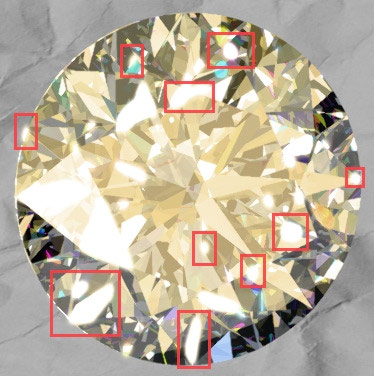
Lighting panorama with high dynamic range (HDR)
A lighting environment can be defined by a high dynamic range panorama (also referred to as HDR panorama). Luminance or radiance observed in the real world can usually be stored in special high dynamic range images that correspond to actual physical values. This additional information makes high dynamic range images that are different to traditional digital images that may appear on a monitor or on a paper print. For example in the photo image above the bright parts of the sky radiate much more light than is seen in a regular photograph, and such intense light sources can create a bloom or flare in a gemstone.

Lighting with generated panorama (zones and light sources)
Panoramas with different light sources can be generated by specifying the size and quantity of light sources.

Panoramas with colored zones (up to 8 zones) can also be generated.

A panorama for the «Office» lighting environment can also be generated.

Paper sheet environment
A paper sheet can be rendered either using an external texture or one that is a generated in a grid-style. In the latter case, you can customize grid settings, paper color, size and other options.
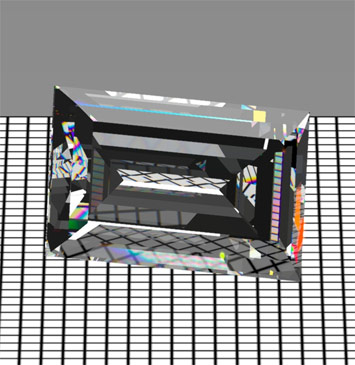
Observer model
DiamCalc 3.0 supports a 2D observer model. The observer model consists of two parts: the observer head and the observer body. This observer model design allows simulation of a head inclined above a gem being observed. You can set up the observer height, eye position, shoulder position, head incline angle and mask parameters.
2. ETAS images
Additional features in new version of DiamCalc include ETAS images (effective total angular size) which at a glance give a good indication of where a diamond can gather light that creates brightness and sparkle. The image on the left shows an ETAS images from the diamonds perspective overlain on the HDR image of the observer placed inside a ballroom. The image on the right is a DETAS image for an emerald cut that shows the dynamic probability to see a sparkle as the diamond is rocked through a small range of north south motion.
ETAS is the basic functional tool for the quantification of the basic light performance responses calculated by DiamCalc3. But DiamCalc3 takes this a further stage by computing for two eyes and other observer specific variables such as pupil size and viewing distance. Dynamic ETAS (DETAS) is a metric for quantification of scintillation.
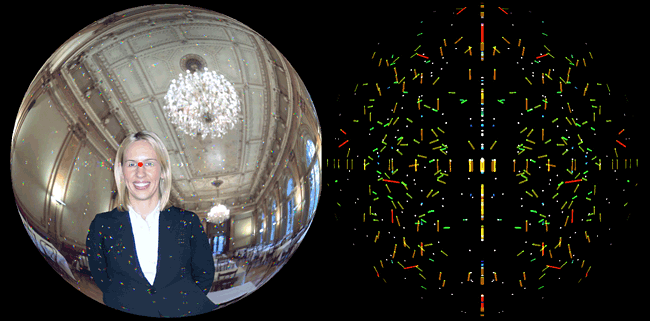
3. Cut Designer builds variable models
For companies active in designing special cuts such as many Sightholders, Tiffany and Swarovski, the new cut designer tool enables the creation of parametric models with tied proportions; each and parameters can be varied. This overcomes a problem in previous computer aided design software that required the laborious creation of separate models for every new proportion set.
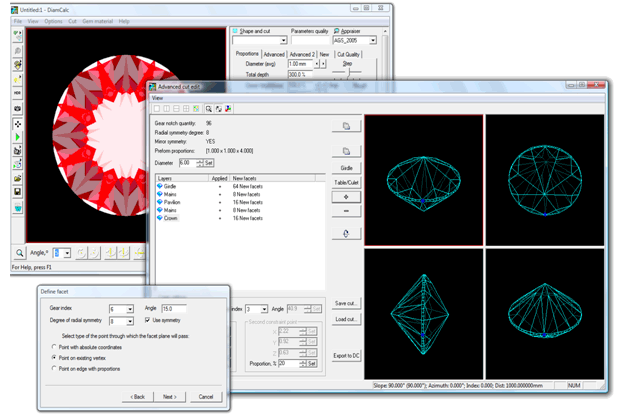
4. Simulation algorithm for stereoscopic photorealistic view of diamond is improved
Algorithm used in simulation of stereoscopic photorealistic view of diamond has been found incorrect in some cases (this algorithm is implemented when "Observer\Head and eyes\Brain picture\Smart bright" option is selected and also when "Light return stereo" Cut Quality index is computed). So the computation was redesigned and the photorealistic image in the mentioned mode and "Light return stereo" index values will differ from those obtained in older versions.
5. Added Natural Diamond and Cubic Zirconia to the list of materials for setting refraction in Gem properties
Open panel Gem properties from menu Gem Material -> View / Modify properties… Press button Select from list… The panel Gem material list will open. Where you can find new materials.
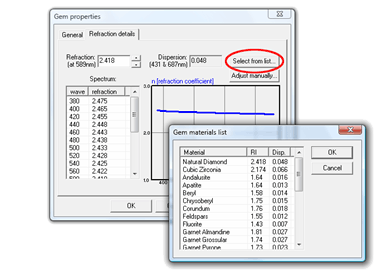
6. Added the GIA PCT 2006 appraiser for Brilliant cut
This appraiser provides estimation of the overall cut quality, using several cut parameters simultaneously, namely Pavilion, Crown and Table. The parameters that are taken into account during stone appraisal are displayed in gray, red or green color. The red color means that it is necessary to decrease the parameter value to get to a better group, the green color suggests to increase the parameter value. There is also a special button «Better group» that changes all parameters of the stone to move it to a nearest better group. Organization of this appraiser is similar to AGS_2005.
|




















